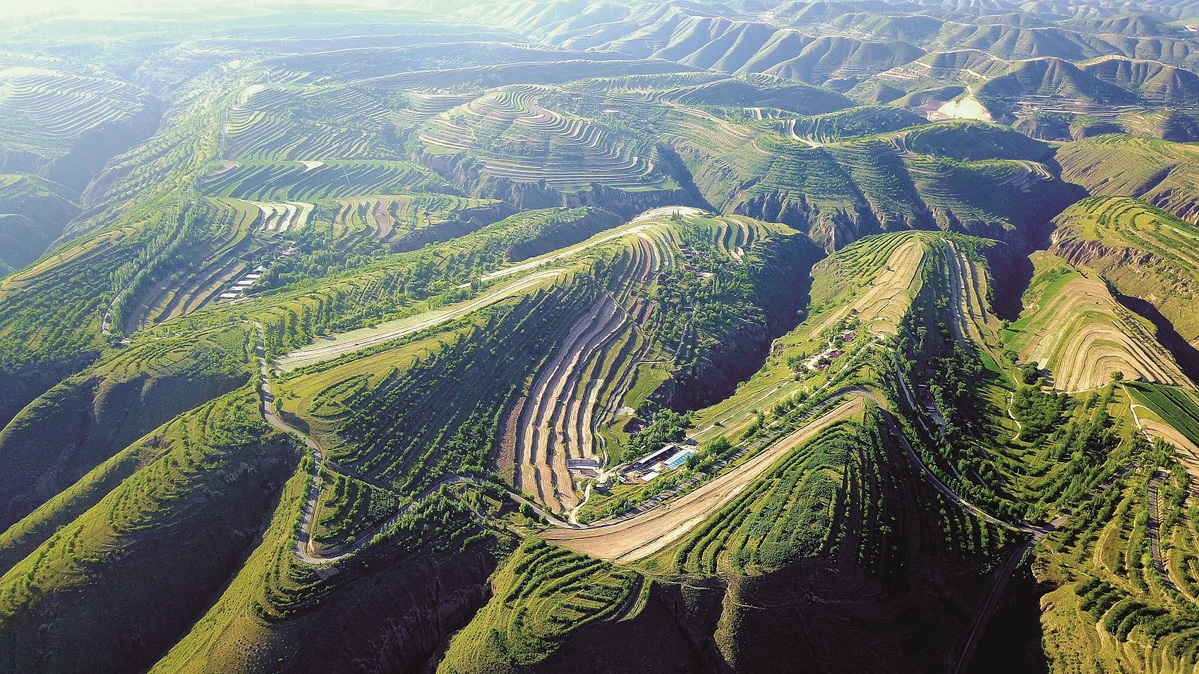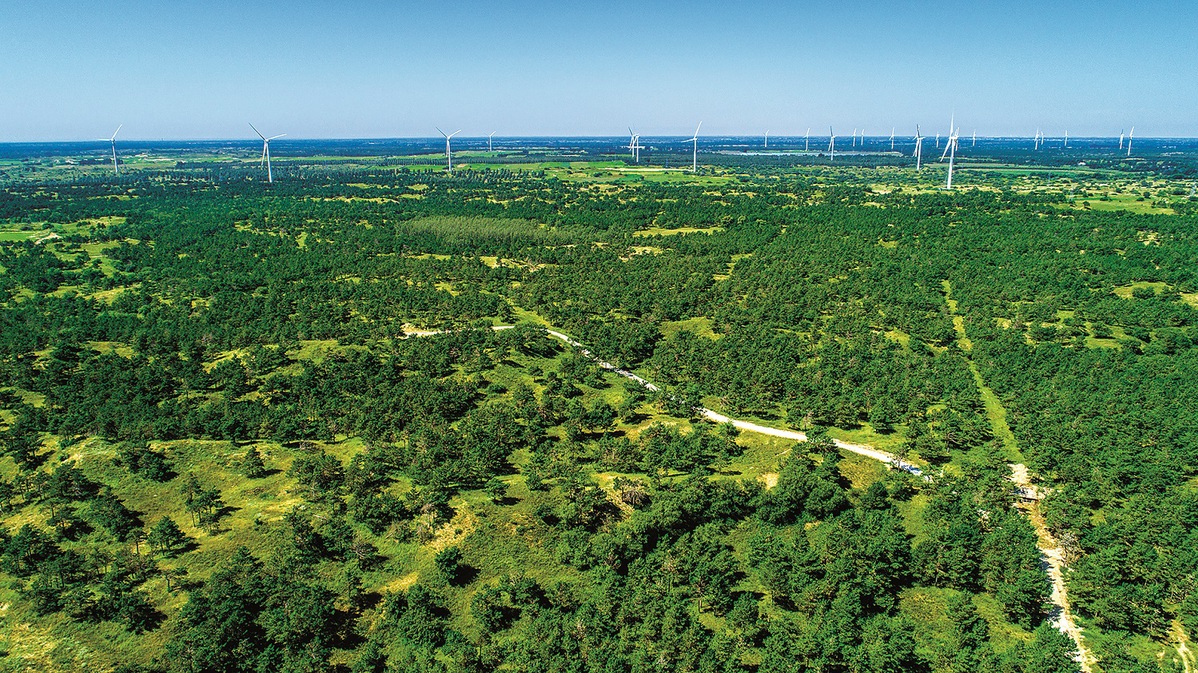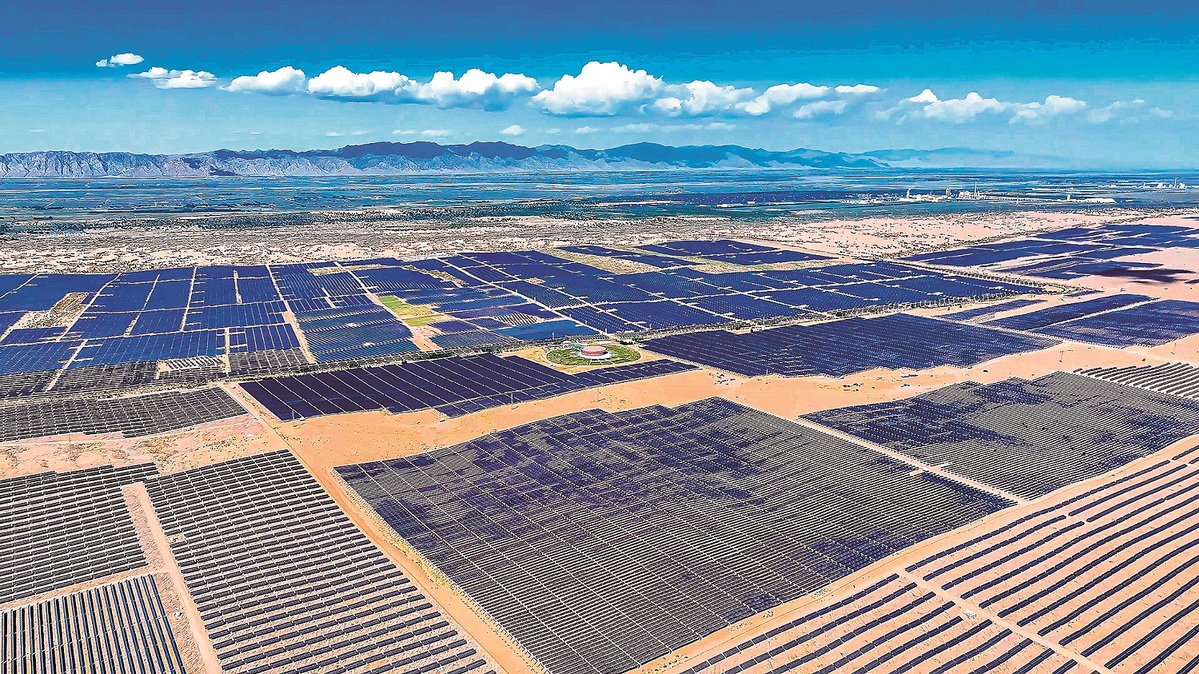
After reclaiming farmland in Fengzhuang town of Pengyang county in Ningxia Hui autonomous region, the once barren mountains are transformed into a beautiful scene of green slopes. YANG JUHUI/FOR CHINA DAILY
China, one of the countries with the severest desertification, has made significant progress in curbing the expansion of deserts after decades of relentless efforts, taking the lead globally to achieve zero-growth in land degradation and become the largest contributor to global afforestation, according to China's National Forestry and Grassland Administration.
Since the 18th National Congress of the Communist Party of China in 2012, 53 percent of desert land in China has been effectively managed, resulting in a net reduction of 4.3 million hectares.
A series of projects in tackling desertification, including the Three-North Shelterbelt Forest Program, which was launched in 1978 and scheduled to be completed in 2050, have played key roles in making such achievements.
Covering 13 provinces and autonomous regions in northern China, the TSFP has helped China control more than 45 percent of the desertified land and manage about 61 percent of the soil erosion area over the past 45 years. Also, the forest coverage rate has been increased from just more than 5 percent to almost 14 percent.

The Horqin Sandy Land in Zhangwu, Liaoning province, is now a lush landscape after being reclaimed and restored. CHINA DAILY
In June 2023, China proposed that the TSFP be turned into a fully functional, unbreakable "green Great Wall" and ecological security barrier in northern China.
Since the 18th National Congress of the Communist Party of China in 2012, the country has intensified support for key ecological projects such as the TSFP.
Besides promoting initiatives aimed at controlling desertification, the establishment of a robust and effective legal framework has also ensured China's desertification efforts can be carried out effectively, Guan Zhi'ou, head of the administration, said in November.
Currently, the legal framework includes six national laws, including laws for sand prevention and control, as well as forest and wetland conservation, Guan noted, adding that the 13 key provincial regions for desertification control have all enacted regional regulations on the issue.
Due to these efforts, northern China has embraced a remarkable decrease in the number of days with severe spring sandstorms.
The World Atlas of Desertification warns that 75 percent of the world's soils are already degraded, affecting 3.2 billion people globally. Projections by the UNESCO are dire, with 90 percent of the planet's land surface identified as being at risk of degradation by 2050, posing significant threats to biodiversity and human life.
In stark contrast to this global outlook, China has achieved zero growth in land degradation and has reduced its area of desertified and sandy lands.
A 2020 report from the Chinese Academy of Sciences indicated that China had achieved land degradation neutrality, with the net land restoration area accounting for more than 18 percent of the world's total, placing it at the forefront of global efforts in this regard.
Moreover, China has taken a systematic and scientific approach to combating desertification, encompassing mountains, bodies of water, forests, farmland, lakes, grassland and deserts. As one of the leading guidelines, the National Desertification Prevention and Control Plan (2021-30) lists coordinated measures among different regions, based on their situations, and outlines measures to reach various targets. More than 6.67 million hectares of desertified land will be treated by 2025, rising to more than 12.4 million hectares by 2030, according to the plan.

A view of the Kubuqi photovoltaic desertification control project in Ordos, the Inner Mongolia autonomous region. CHINA DAILY
Innovative solutions
In the face of its severe desertification challenge, China has consistently emphasized technology-driven green development over the past few decades and explored various models of desertification control.
To prevent traffic arteries and newly planted grasses and trees from being quickly engulfed by moving dunes, the "straw checkerboards" — a dune fixation technique in which straw is placed on the desert surface in the shape of a checkerboard — were applied more than 60 years ago in Zhongwei, a city near the Tengger Desert in Northwest China's Ningxia Hui autonomous region.
Within the checkerboards, the surface of the sand forms a hard crust over time which prevents the sand from moving.
In addition, intelligent and innovative equipment has been developed and applied to improve the efficiency and effectiveness of sand control, such as the walk-behind paving machine that can more efficiently "plant" straw nets and the AI-powered automated seeding machine. China has also been promoting precise sand control methods, such as adjusting the density of afforestation according to the capacity of local water resources, avoiding the decline of young and medium-sized trees, and realizing a sustainable growth of vegetation.
Thanks to decades of sand control efforts, China has achieved the historic transition from desert displacing human settlements to green oases replacing desert areas. China has cultivated the world's largest man-made forest in Saihanba in North China's Hebei province, and created a China model of sand control by greening and transforming the vast desert in Kubuqi, Inner Mongolia autonomous region.
More than ever, desertification control measures are backed by scientific research and the use of the latest technology, said Lu Qi, head of the Three-North program research institute.
"Each desertification control project is now planned based on the conditions and resources of different areas backed by research data. And people have reached a consensus that the goal of desertification control is to ensure that people's lives and development won't be threatened by deserts, which also need to be protected as they are essential parts of the ecological system," said Lu.
In Ordos city, Inner Mongolia, a "photovoltaic Great Wall" running along the greenbelt on the edge of the Kubuqi Desert is taking shape. After its completion in 2030, the "photovoltaic Great Wall" consisting of photovoltaic panels will have an average width of 5 kilometers and stretch for 400 km. That's farther than the distance between London and Paris.
Different from regular photovoltaic projects, all the panels installed on this project have been raised more than 3 meters above the ground, allowing sand-binding plants and agricultural products to grow underneath.
The project, which is only 5 km from the Yellow River, is expected to achieve an installed capacity of 100 million kilowatts and help to treat 200,000 hectares of sandy land. It will also act as a wind and sand barrier along the watercourse. The integration of ecological treatment and energy development is expected to inject new vitality into desertification control.

Idyllic scenery of Sanguyao village in Tiebiancheng town of Wuqi county, Shaanxi province, after the reforestation. WU ZONGKAI/FOR CHINA DAILY
Global cooperation
The fight against desertification has become a global issue, making international cooperation essential. While taking the lead in combating desertification over the past decades, China has extensively carried out international exchanges and cooperation, sharing its experience with countries that face similar challenges.
In 1977, China shared the anti-desertification technique used in Zhongwei at the UN Conference on Desertification in Nairobi. Now the technique, which is convenient, cost-effective and environmentally friendly, remains a crucial way of stopping sand encroachment worldwide. Since 2005, researchers from Xinjiang Institute of Ecology and Geography of the Chinese Academy of Sciences have been sharing mature desertification control technologies with Central Asia and Africa through workshops and field practice.
China has been actively fulfilling its obligations under the UN Convention to Combat Desertification, establishing the International Knowledge Management Center on Combating Desertification in the Ningxia Hui autonomous region in February 2019, which aims to share China's wisdom and experience in combating desertification with other countries all over the world.
In August 2023, China held the ninth Kubuqi International Desert Forum in Inner Mongolia, with an aim to deepen international cooperation on desertification prevention and control driven by science and technology.